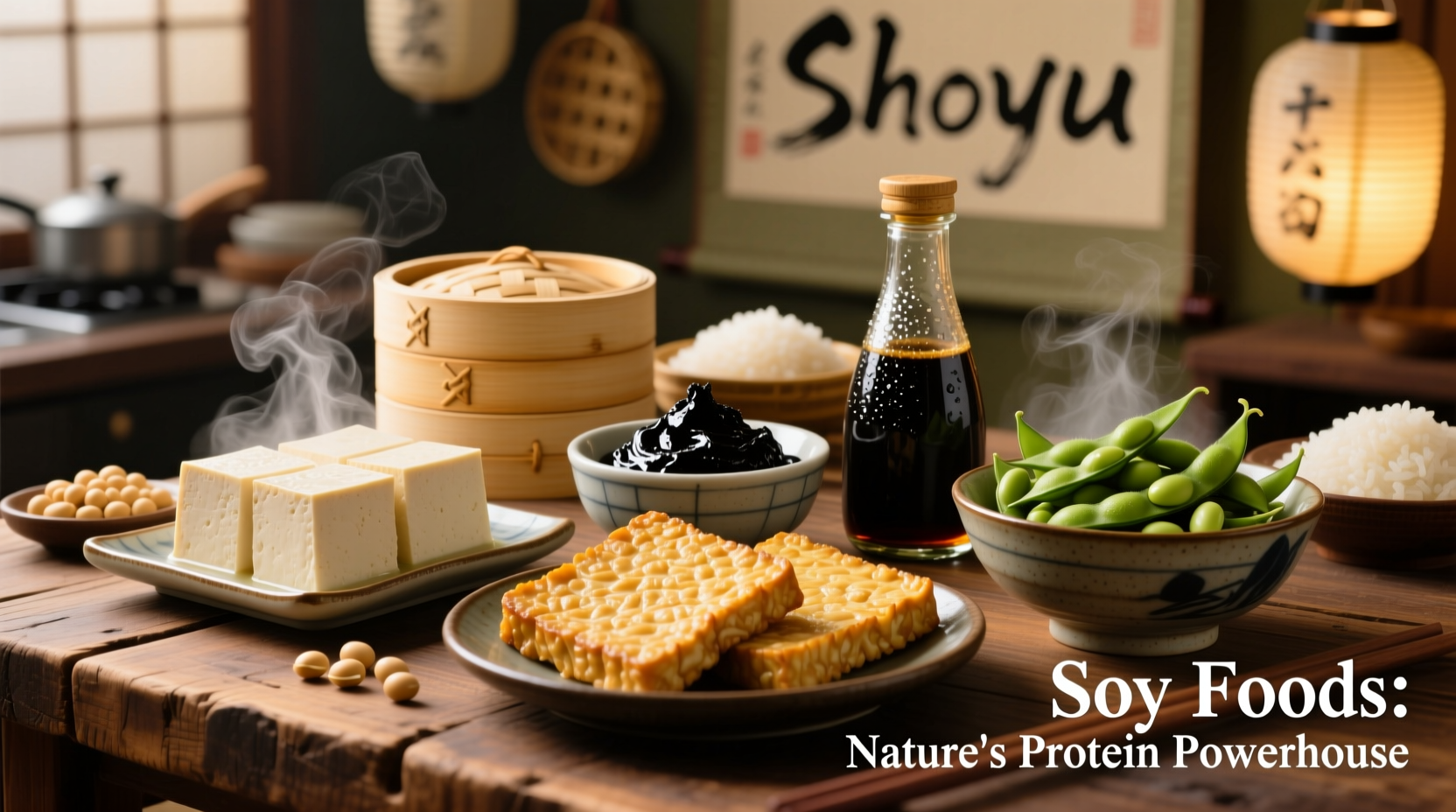Understanding which foods contain soy is essential for dietary planning, allergy management, and exploring plant-based nutrition. As a staple in Asian cuisine for thousands of years, soy has evolved into one of the world's most versatile protein sources with applications spanning traditional dishes to modern food technology.
Whole Soybean Foods: Nature's Complete Package
Whole soybeans represent the least processed form of soy, retaining their complete nutritional profile including protein, fiber, and essential fatty acids. Unlike refined soy products, these maintain the bean's natural structure and nutrient synergy.
Edamame - Young, green soybeans harvested before maturity. Commonly served steamed with salt in Japanese cuisine, they contain approximately 17g protein per cup. The USDA FoodData Central confirms edamame provides complete protein with all nine essential amino acids.
Roasted Soy Nuts - Mature soybeans roasted until crunchy. These contain nearly double the protein of peanuts by weight and maintain the bean's natural isoflavone content. Proper roasting at 300°F for 30-40 minutes preserves nutritional value while developing rich flavor.

Fermented Soy Powerhouses
Fermentation transforms soybeans through microbial action, enhancing digestibility and creating unique compounds. Traditional Asian cultures developed these methods centuries ago to improve soy's nutritional profile.
Miso - Japanese seasoning paste made from soybeans fermented with koji mold. Different varieties (white, red, barley) offer distinct flavor profiles and fermentation durations from weeks to years. According to research published in the Journal of Nutritional Science and Vitaminology, fermentation increases bioactive peptide content.
Tempeh - Indonesian product where whole soybeans are fermented into a firm cake. Unlike tofu, tempeh maintains the bean's structure, providing 20g protein per 4-ounce serving and significant vitamin B12 from the fermentation process.
Natto - Japanese specialty featuring sticky, pungent fermented soybeans. Contains exceptionally high levels of vitamin K2 (menaquinone-7), with studies showing natto provides superior K2 absorption compared to supplements.
Traditional Soy Staples
These foundational soy products form the backbone of Asian cooking and have gained global popularity for their versatility.
Tofu - Made by coagulating soy milk, available in silken, soft, firm, and extra-firm varieties. The coagulation method (nigari, gypsum, or acid) affects texture and nutritional properties. Harvard T.H. Chan School of Public Health notes that calcium-set tofu provides significant dietary calcium.
Soy Sauce - Brewed from soybeans and wheat through fermentation. Traditional brewing takes months, while chemical hydrolysis produces inferior products faster. Japanese shoyu and Chinese jiangyou differ in wheat content and fermentation methods.
Soy Milk - Created by soaking, grinding, and boiling soybeans. Unlike dairy milk, it contains no cholesterol and provides comparable protein. The FDA recognizes that 25g daily soy protein may reduce heart disease risk.
| Soy Food Type | Protein (per 100g) | Key Nutrients | Traditional Origin |
|---|---|---|---|
| Edamame | 11g | Fiber, Vitamin K, Folate | China/Japan |
| Firm Tofu | 8g | Calcium, Iron, Magnesium | China |
| Tempeh | 19g | Vitamin B12, Probiotics | Indonesia |
| Miso | 12g | Sodium, Enzymes, Isoflavones | Japan |
Modern Soy-Derived Ingredients
Food science has expanded soy's applications through various processing techniques. These ingredients appear in countless packaged foods, often unrecognized by consumers.
Soy Protein Isolate - 90%+ protein content after removing fats and carbohydrates. Common in protein powders and meat alternatives. The extraction process involves alkaline washes and acid precipitation to isolate protein fractions.
Soy Lecithin - Emulsifier derived from soybean oil processing. Found in chocolate, baked goods, and supplements. The European Food Safety Authority confirms its safety as a food additive at typical consumption levels.
Soy Flour - Made from roasted, defatted soybeans ground into powder. Contains approximately 50% protein and is used in baked goods to enhance nutrition. Different varieties (full-fat, low-fat, defatted) serve specific culinary purposes.
Plant-Based Meat Alternatives
The growing plant-based movement has propelled soy into innovative meat substitutes. These products mimic meat texture through specialized processing.
TVP (Textured Vegetable Protein) - Dehydrated soy product reconstituted with water. Made by extruding soy flour under heat and pressure to create fibrous texture. Common in vegetarian chili and taco fillings.
Soy-Based Burgers and Sausages - Advanced formulations combine soy protein with other ingredients to replicate meat's sensory properties. Modern products often include heme (from soy leghemoglobin) to mimic meat's flavor and cooking characteristics.
Hidden Sources of Soy
Soy appears in unexpected places throughout the food supply. Reading labels carefully is essential for those managing soy allergies or dietary restrictions.
- Vegetable Broth and Stock - Often contains soy protein or soy sauce derivatives
- Processed Meats - Soy protein extends products like hot dogs and deli meats
- Baked Goods - Soy flour improves texture and shelf life in commercial breads
- Non-Dairy Creamers - Frequently contain soy protein as a base ingredient
- Infant Formula - Soy-based options serve infants with lactose intolerance
Practical Soy Integration Tips
Successfully incorporating soy foods requires understanding their culinary properties and proper preparation techniques.
Maximizing Flavor - Press firm tofu for 30 minutes before cooking to improve marinade absorption. Marinate in acidic ingredients (vinegar, citrus) for at least 2 hours for deeper flavor penetration.
Cooking Methods - Pan-fry tempeh after steaming to reduce bitterness. Simmer miso in low-heat broth rather than boiling to preserve beneficial enzymes. Freeze then thaw tofu before cooking to create more porous texture that absorbs flavors better.
Allergy Considerations - The Food Allergy Research & Education organization notes that soy allergy affects approximately 0.4% of children, with many outgrowing it by age 10. Always check labels for soy derivatives when managing allergies.
Understanding Soy Controversies
Soy has faced various health concerns, though scientific consensus supports its safety and benefits when consumed as part of a balanced diet.
Regarding phytoestrogens, a comprehensive review in the American Journal of Clinical Nutrition concluded that soy consumption does not affect testosterone levels in men. Similarly, the European Food Safety Authority determined that soy isoflavones do not adversely affect thyroid function in healthy individuals.











 浙公网安备
33010002000092号
浙公网安备
33010002000092号 浙B2-20120091-4
浙B2-20120091-4